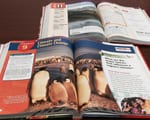
Science writer Laura Geggel with Live Science named a new species of extinct marine mammal identified by two SMU paleontologists among “The 10 Strangest Animal Discoveries of 2015.”
The new species was identified by SMU paleontologist Louis L. Jacobs, a professor in the Roy M. Huffington Department of Earth Sciences, Dedman College of Humanities and Sciences, and paleontologist and SMU adjunct research professor Anthony Fiorillo, vice president of research and collections and chief curator at the Perot Museum of Nature and Science.
Jacobs and Fiorillo co-authored a study about the identification of new fossils from the oddball creature Desmostylia, discovered in the same waters where the popular “Deadliest Catch” TV show is filmed. The hippo-like creature ate like a vacuum cleaner and is a new genus and species of the only order of marine mammals ever to go extinct — surviving a mere 23 million years.
Desmostylians, every single species combined, lived in an interval between 33 million and 10 million years ago. Their strange columnar teeth and odd style of eating don’t occur in any other animal, Jacobs said.
The LiveScience article published Dec. 23, 2015.
EXCERPT:
By Laura Geggle
Live Science
[/fusion_builder_column][fusion_builder_column type=”1_1″ background_position=”left top” background_color=”” border_size=”” border_color=”” border_style=”solid” spacing=”yes” background_image=”” background_repeat=”no-repeat” padding=”” margin_top=”0px” margin_bottom=”0px” class=”” id=”” animation_type=”” animation_speed=”0.3″ animation_direction=”left” hide_on_mobile=”no” center_content=”no” min_height=”none”][ … ] It might not help clean the living room, but about 23 million years ago a hippo-size mammal used its long snout as a vacuum cleaner, suctioning up tasty morsels of marine algae and sea grass along the coast.The newly identified extinct animal (Ounalashkastylus tomidai) belongs to the order Desmostylia, the only known order of marine mammals to go completely extinct, the researchers told Live Science in October.
The scientists found four O. tomidai skeletons, including one baby, on the Aleutian Islands’ Unalaska.
“The baby tells us they had a breeding population up there,” said study co-author Louis Jacobs, a vertebrate paleontologist at Southern Methodist University in Texas. “They must have stayed in sheltered areas to protect the young from surf and currents.” [ … ]
Follow SMUResearch.com on twitter at @smuresearch.
SMU is a nationally ranked private university in Dallas founded 100 years ago. Today, SMU enrolls nearly 11,000 students who benefit from the academic opportunities and international reach of seven degree-granting schools. For more information see www.smu.edu.
SMU has an uplink facility located on campus for live TV, radio, or online interviews. To speak with an SMU expert or book an SMU guest in the studio, call SMU News & Communications at 214-768-7650.


 California 6th grade science books: Climate change a matter of opinion not scientific fact
California 6th grade science books: Climate change a matter of opinion not scientific fact